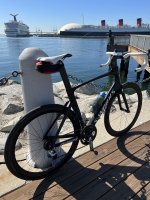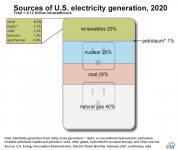People have been falling for many things for over ... forever. Examples closer to home, audio cables, DAC jitter.
That's because there is one born every minute. By the time people catch on, up comes the next generation of suckers. These pranksters never run out of customers.
DAC jitter. Good one.
That's because everything is spread out. Most American cities no longer have stores and eateries within walking distance of residential area (blame the 50's & 60's urban renewal projects).
I grew up in the inner city and there were corner grocery stores every few blocks. These weren't like the current convenience stores, they had fresh produce and fresh meat. The owners worked there and knew all of their customers by name. This was a working class, blue collar neighborhood and most people took the bus or train to work. Just about everything you needed to live a good life was in walking distance. Most of my teenage friends did not have cars, we rode our bicycles in the spring, summer and fall and took the bus or train in the winter. I still live in the inner city and get around pretty much the same way as when i was a teen, I only drive when necessary. Unfortunately, most Americans cannot live this way. "Big Box" stores have replaced corner stores and are only accessible to most by car.
2011 I was working on a large building site, one day posters went up...Where did the power to charge your battery come from?
That was the question...which does not occur to most people.
SAVE ENERGY PLEASE TURN THE LIGHTS OFF AND USE CORDLESS POWER TOOLS WHERE POSSIBLE
yeh right 🙂
The only reason I wouldn't swim in them is it's too damned cold. Except Frenchman's bay where Pickering nuclear warms the water 🙂 Just keep your head above the water 🙂Yes its polluted af from separate incidences. You wouldn't catch me swimming in L. Erie or L. Ontario for that matter.
That is what a brace and bit are good for.2011 I was working on a large building site, one day posters went up...
USE CORDLESS POWER TOOLS WHERE POSSIBLE
yeh right 🙂
The auger bits are still quite common. The biggest issue is knowing how to sharpen them.
Not only are there the common brace type drills, I even have an “electricians” drill. Ever wonder how they got holes to wire places when a hand brace couldn’t swing it?
Zebra mussels and restructured storm drains appear to have remedied much of that. Lake Ontario is remarkably clear most of the year and Toronto beaches haven't closed in ages. Then again I'm old enough to recall when the Erie shoreline was a continuous carpet of dead fish due to the phosphates.You wouldn't catch me swimming in L. Erie or L. Ontario for that matter.
But the main issue is how much of it comes from what source. When you look at how much electric is supplied from wind and sun vs. fossil fuel, especially how much investment is put into those, it may change your perspective, unless you already went through it.With electricity you can choose how to generate it. Wind, sun, hydro, it is possible. With fossil fuel there is no choice. Earth is not happy.
Electric is nice if you live in Québec:
- In 2018, Quebec generated 213.7 terawatt hours (TW.h) of electricity, which is approximately one third of total Canadian generation. Quebec is the largest producer of electricity in Canada and has a generating capacity of 46 176 megawatts (MW).
- With over 40 853 MW of installed capacity, hydroelectric stations generate about 95% of Quebec’s electricity. This includes Canada’s largest hydroelectric power plant, the 5 616 MW Robert-Bourassa facility in northern Quebec, which is currently under rehabilitation until 2022. Another major hydroelectric station, the Romaine Complex, is currently under construction on the La Romaine River in Côte-Nord. When completed, it will have a capacity of 1 550 MW from four generating stations. Romaine-1 (270 MW), Romaine-2 (640 MW), and Romaine-3 (395 MW) are already in-service. The final station, Romaine-4 with 245 MW capacity is expected to be online in 2021.
- Wind is the 2nd largest source of electricity generation in Quebec. In 2018, wind capacity reached 4 096 MW and accounted for 4% of the province’s generating capacity. The last wind farm to be commissioned was Mont Sainte-Marguerite, with a generating capacity of 143 MW in March 2018. The 225 MW Nicolas-Riou wind farm was also commissioned in 2018.
- Other sources of electricity generation include natural gas (mainly for peak winter demand), diesel (for power in remote communities), and biomass.
- In 2018, Ontario generated 151 terawatt hours (TW.h) of electricity, which is approximately 23% of total Canadian generation. Ontario is the 2nd largest producer of electricity in Canada and has a generating capacity of 40 671 megawatts (MW).
- In 2018, about 96% of electricity in Ontario is produced from zero-carbon emitting sources: 60% from nuclear, 26% from hydroelectricity, 7% from wind, and 2% from solar. The remainder is primarily from natural gas, with some biomass. Ontario’s electricity generating capacity is primarily located in the southern portion of the province with significant hydro generating stations located in eastern Ontario in the Ottawa River basin and northeastern Ontario in the Moose River basin.
- Three nuclear power plants with a combined 12 633 MW of installed capacity provide the bulk of Ontario’s baseload generation. Bruce Power on the east shore of Lake Huron is the largest, with eight generation units and a capacity of about 6 600 MW. It is one of the largest nuclear power plants currently operating in the world.
- Ontario has over 200 hydroelectricity generation facilities with a total capacity of
9 251 MW. - Ontario leads Canada in wind capacity. About 5 061 MW of wind capacity was added between 2005 and 2018.
- About 98% of solar capacity in Canada is installed in Ontario. In 2018, solar in Ontario had a total capacity of 2 871 MW.
- Ontario has the largest 100% biomass-fueled plant in North America. The 205 MW Atikokan Generating Station was converted from coal in 2014.
Last edited:
https://www.eia.gov/tools/faqs/faq.php?id=427&t=3But the main issue is how much of it comes from what source. When you look at how much electric is supplied from wind and sun vs. fossil fuel, especially how much investment is put into those, it may change your perspective, unless you already went through it.
As most charging is done at off peak times, less comes from combustion. Natural gas is the popular peaker power source as start up times are quite fast. As hydro is constant coal power is also adjusted downward as demand drops. Wind is maximum usually at dusk and dawn.
Even in the US coal is under 22% for all electric generation and dropping.
Thermal power stations still play a major part in ensuring the frequency stability of the electricity supply.
Solar and wind technologies are more difficult to control.
Solar and wind technologies are more difficult to control.
Where did you pull that weird idea from?Someone did say that in that in the end, an electric car is a coal powered car, as the electricity came from burning coal...
🙂
Coal is the worst fossil fuel available, much shunned all over the World and only used out of desperation or by Countries who favor Industry at all costs and couldn´t care less about others (China).
The GREAT point about electrical cars is they allow clean but fixed point Energy: Hydro and Nuclear mainly, into a form light and portable enough to be carried on 4 wheels away from the grid.
Electric trains, tramways, trolley buses, subways, etc. allow for clean efficient transportation for way over 100 years now, but of course along power lines.
The eia.Where did you pull that weird idea from?
Attachments
Well...Solar and wind are intermittent, no control at all.Thermal power stations still play a major part in ensuring the frequency stability of the electricity supply.
Solar and wind technologies are more difficult to control.
Wind electricity is only 25% available over all of lands in Europe. The 75% of the time with near no wind, power MUST come from sources one can control. Without nuclear, that is gas mostly, from Russia. The situation is so bad that we will boost electricity generation from coal.
I meant in terms of frequency control when they are working.
Generators can be sped up and slowed down.
Generators can be sped up and slowed down.
Nor is 7.3% hydro the 50% implied in yours. 59% of power generation is still fossil fuel based.19% is not 100% as implied in Naresh´s post.
So with an electric car you run 41% non fossil, and this can (and will) improve, if we want. Better than nothing.59% of power generation is still fossil fuel based.
In Denmark wind provides 50% of electricity, they aim for 85% by 2035. To be honest, it is a rather windy country..
WHO mentioned Hydro?Nor is 7.3% hydro the 50% implied in yours. 59% of power generation is still fossil fuel based.
- Status
- Not open for further replies.
- Home
- Member Areas
- The Lounge
- Gas prices

